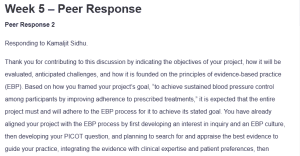Week 5 – Peer Response
Peer Response 2
Responding to Kamaljit Sidhu.
Thank you for contributing to this discussion by indicating the objectives of your project, how it will be evaluated, anticipated challenges, and how it is founded on the principles of evidence-based practice (EBP). Based on how you framed your project’s goal, “to achieve sustained blood pressure control among participants by improving adherence to prescribed treatments,” it is expected that the entire project must and will adhere to the EBP process for it to achieve its stated goal. You have already aligned your project with the EBP process by first developing an interest in inquiry and an EBP culture, then developing your PICOT question, and planning to search for and appraise the best evidence to guide your practice, integrating the evidence with clinical expertise and patient preferences, then evaluating outcomes (Tucker & Gallagher-Ford, 2019). A major goal of engaging in evidence-based inquiry is to develop and evaluate the quality of current evidence, which is then used to improve the quality and outcomes of health care by closing the gap between research and practice (Robinson et al., 2021). All of these are the main objectives of your project, which align with the principles of EBP.
As you have noted, the EBP process faces various challenges. Most of these challenges arise due to a lack of readiness for practice change among the stakeholders during the implementation of the EBP. Besides using regular follow-ups and incentives, which may be misinterpreted and also may not always work, you can focus on improving the participants’ knowledge and skills on the process, which effectively improves their active participation and involvement throughout the EBP process (Alqahtani et al., 2020). Therefore, your will able to able to easily integrate best practices, clinical expertise, and patient-centered care in your project and improve hypertension outcomes.
References
Alqahtani, N., Oh, K. M., Kitsantas, P., & Rodan, M. (2020). Nurses’ evidence-based practice knowledge, attitudes and implementation: A cross-sectional study. Journal of Clinical Nursing, 29(1–2), 274–283. https://doi.org/10.1111/JOCN.15097
Robinson, K. A., Brunnhuber, K., Ciliska, D., Juhl, C. B., Christensen, R., & Lund, H. (2021). Evidence-Based Research Series-Paper 1: What Evidence-Based Research is and why is it important? Journal of Clinical Epidemiology, 129, 151–157. https://doi.org/10.1016/J.JCLINEPI.2020.07.020
Tucker, S. J., & Gallagher-Ford, L. (2019). EBP 2.0: From Strategy to Implementation. American Journal of Nursing, 119(4), 50–52. https://doi.org/10.1097/01.NAJ.0000554549.01028.AF
ORDER A PLAGIARISM-FREE PAPER HERE
We’ll write everything from scratch
Question
PEER RESPONSE 2:
BY: Kamaljit Sidhu
A primary goal of the project is to achieve sustained blood pressure control among participants by improving adherence to prescribed treatments. Research shows that lifestyle adherence has a significant impact on hypertension control, especially in populations prone to health disparities (Bakker et al., 2021). Thus, this project focuses on improving medication adherence, dietary habits, and physical activity levels, which are critical factors in hypertension management. By targeting these areas, the project aims to reduce overall cardiovascular risk and enhance quality of life in the target population. This evidence-based approach is expected to promote adherence, ultimately resulting in better patient outcomes.
Evaluation of the project will involve multiple measures to ensure a comprehensive understanding of its impact. Blood pressure readings taken before and after the intervention will provide quantitative data on the intervention’s effectiveness in managing hypertension. Self-reported surveys will be used to assess participants’ adherence to medication, diet, and exercise, cross-referenced with clinical records for accuracy (Chow et al., 2023). These objective and subjective measures will allow for a thorough evaluation of the intervention’s effectiveness and its ability to encourage lifestyle changes.
Despite the strengths of this project, several challenges are anticipated in ensuring participant adherence and accurate reporting. Self-reported data may be subject to recall bias, which could affect the reliability of adherence data (Martinez & Patel, 2021). To address this, the project will include regular follow-ups and support from healthcare providers who can reinforce adherence. Another anticipated challenge is the potential for participant dropout, which may affect data continuity. To address this, culturally relevant incentives will be provided to encourage consistent participation. By anticipating these challenges, the project can better ensure the accuracy and completeness of its findings.
This project’s EBP foundation supports not only improved patient outcomes but also broader implications for hypertension management within Asian American communities. Culturally tailored interventions have shown promise in improving adherence and health outcomes within minority populations (Wang et al., 2021). If the intervention proves effective, it could serve as a model for similar programs, guiding healthcare providers in addressing cultural factors in care delivery. Moreover, the project’s results may provide valuable insights into designing hypertension management programs for other minority groups, contributing to the reduction of health disparities on a larger scale.

Week 5 – Peer Response
The success of this EBP-driven project could have a positive impact on healthcare policy and practices, promoting culturally responsive care. By demonstrating the effectiveness of a culturally tailored approach to hypertension management, this project can encourage healthcare organizations and policymakers to prioritize similar initiatives. Such changes in policy and practice could contribute to a more inclusive healthcare system that addresses the specific needs of minority populations, aligning with the goals of EBP to provide high-quality, patient-centered care (Hickman et al., 2020). The project’s findings may inspire further research and development of interventions targeting health disparities, thus amplifying its impact.
In conclusion, my capstone project emphasizes EBP by integrating best practices, clinical expertise, and patient-centered care to manage hypertension in a culturally relevant manner. The anticipated outcomes align with EBP goals of enhancing patient health and reducing health disparities, contributing to a more equitable healthcare system. Through a robust evaluation process, the project will generate valuable insights into the efficacy of culturally tailored interventions, addressing a critical community need and advancing EBP in hypertension management. The results will serve as a foundation for further research, policy development, and practical applications in the field of healthcare.

